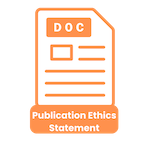Gambaran Pola Aktivitas dan Kebiasaan Makan Remaja Selama Pandemi Covid-19
Abstract
Pandemi Covid-19 telah membawa dampak dalam sistem pendidikan yakni pemberlakukan Social distancing dan Work From Home sehingga proses pembelajaran dilakukan melalui metode daring. Pola aktivitas remaja berubah menjadi lebih pasif dan berkurang dengan belajar dari rumah. Sementara itu, penelitian membuktikan bahwa kurangnya pola aktivitas merupakan faktor penyebab obesitas dan penyakit-penyakit lain. Penelitian ini menggunakan 754 sampel remaja yang menjalani pembelajaran daring sekolah dari rumah. Sampel mengisi kuesioner tentang pola aktivitas fisik dan pola makan selama pandemi covid-19. Penelitian ini bertujuan untuk mendapatkan gambaran pola aktivitas fisik dan pola makan remaja selama pandemi Covid-19. Hasil penelitian ini menunjukkan bahwa terjadi penurunan pola aktivitas selama pandemi Covid -19. Kegiatan yang paling panyak dilakukan adalah berjalan kaki (77,2%), jogging (40,9%), dan bersepeda (35, 9%). Selain itu, konsumsi minuman minuman bersoda dan minuman manis pada sampel remaja terbukti tinggi yakni masing-masing 36,5% dan 83 %. Melalui penelitian ini diharapkan adanya strategi dan upaya untuk meningkatkan pola aktivitas fisik remaja dan mengurangi konsumsi minuman kemasan selama pandemi Covid -19
References
Altius, J., & Olahraga, J. I. (2020). Aktivitas Olahraga Masyarakat pada Masa Pandemi Covid-19 berdasarkan Usia. 9(2), 32–38.
Ammar, A., Chtourou, H., & Boukhris, Omar, E. a. (2020). Covid-19 home confinement negatively impacts social participation and life satisfaction: A worldwide multicenter study. International Journal of Environmental Research and Public Health, 17(17), 1–17. https://doi.org/10.3390/ijerph17176237
Booth, F. W., Roberts, C. K., & Laye, M. J. (2012). Lack of exercise is a major cause of chronic diseases. Comprehensive Physiology, 2(2), 1143–1211. https://doi.org/10.1002/cphy.c110025
Donen, H. (2005). The Physical Activity Questionnaire for Older Children (PAQ-C) and Adolescents (PAQ-A) Manual. College of Kinesiology, University of Saskatchewan, 87(August), 1–38. Retrieved from papers://305a9bed-f721-4261-8df7-5414758c1624/Paper/p910
Drenowatz, C., Gribben, N., Wirth, M. D., Hand, G. A., Shook, R. P., Burgess, S., & Blair, S. N. (2016). The Association of Physical Activity during Weekdays and Weekend with Body Composition in Young Adults. 2016.
Hotamisligil, M. F. G. and G. S. (2011). Inflammatory Mechanisms in Obesity. Annual Review of Immunology, 29, 415–455.
İsmet Kazaz, Msca, Ender Angın, PhDb,∗, Seray Kabaran, PhDb, Gözde İyigün, PhDb, Berkiye Kırmızıgil, PhDb, Mehtap Malkoç, P. (2018). Evaluation of the physical activity level, nutrition quality, and depression in patients with metabolic syndrome. Medicine, (97), 1–6.
Kowalski, K. C., & Ph, D. (2004). The Physical Activity Questionnaire for Older Children ( PAQ-C ) and Adolescents ( PAQ-A ) Manual. (August).
Mahumud, R. A., Sahle, B. W., Owusu-Addo, E., & ert.al. (2021). Association of dietary intake, physical activity, and sedentary behaviours with overweight and obesity among 282,213 adolescents in 89 low and middle income to high-income countries. International Journal of Obesity, 45(11), 2404–2418. https://doi.org/10.1038/s41366-021-00908-0
Martina, & Adisasmita, A. C. (2019). Association between Physical Activity and Obesity with Diabetes Mellitus in Indonesia. International Journal of Caring Sciences, 12(3), 1703–1709. Retrieved from http://search.ebscohost.com/login.aspx?direct=true&db=rzh&AN=139544939&site=ehost-live
Nurhadi, J. Z. L., & Fatahillah. (2020). Pengaruh Pandemi Covid-19 Terhadap Tingkat Aktivitas Fisik Pada Masyarakat Komplek Pratama, Kelurahan Medan Tembung. Jurnal Health Sains, 1(5), 294–299.
Park, K. H., Kim, A. R., Yang, M. A., Lim, S. J., & Park, J. H. (2021). Impact of the COVID-19 pandemic on the lifestyle, mental health, and quality of life of adults in South Korea. PLoS ONE, 16(2 February), 1–13. https://doi.org/10.1371/journal.pone.0247970
Putri, R. M., & Sartika, R. A. D. (2021). Effects Of The Covid-19 Pandemic On Eating Habits And Exercise Habits Of The Selected High School Adolescents In West Lampung Regency. Jurnal Kesehatan Komunitas, 7(2), 164–169. https://doi.org/10.25311/keskom.vol7.iss2.942
Sartika, R. A. D. (2011). Faktor Resiko Obesitas Pada Anak 5-15 Tahun di Indonesia. Makara, 15(1), 37–43.
Schwartz, M. W., Seeley, R. J., Zeltser, L. M., & et.al. (2017). Obesity pathogenesis: An endocrine society scientific statement. Endocrine Reviews, 38(4), 267–296. https://doi.org/10.1210/ER.2017-00111
Silva, D. A. S., Naghavi, M., & Duncan, Bruce B, E. a. (2019). Physical inactivity as risk factor for mortality by diabetes mellitus in Brazil in 1990, 2006, and 2016. Diabetology and Metabolic Syndrome, 11(1), 1–11. https://doi.org/10.1186/s13098-019-0419-9
Simbolon, D., Siregar, A., & Talib, R. A. (2020). Physiological factors and physical activity contribute to the incidence of type 2 diabetes mellitus in Indonesia. Kesmas, 15(3), 120–127. https://doi.org/10.21109/KESMAS.V15I3.3354
Ribna. (2016). Jogging Dan Gaya Hidup Sehat Masyarakat Studi Kasus Kawasan Taman Konservasi Di Lingkungan Kampus Universitas Negeri Semarang SKRIPSI.
Teixeira, M. T., Vitorino, R. S., da Silva, J. H., & Et.al. (2021). Eating habits of children and adolescents during the COVID-19 pandemic: The impact of social isolation. Journal of Human Nutrition and Dietetics, 34(4), 670–678. https://doi.org/10.1111/jhn.12901
UNICEF. (2021). Profil Remaja 2021. Retrieved from https://www.unicef.org/indonesia/media/9546/file/Profil Remaja.pdf
University, B. S., & Rica, C. (2011). Snacking behavior in adolescents and adults in the United States. An Abstract of a Dissertation.
Vartanian, L. R., Schwartz, M. B., & Brownell, K. D. (2007). Effects of soft drink consumption on nutrition and health: A systematic review and meta-analysis. American Journal of Public Health, 97(4), 667–675. https://doi.org/10.2105/AJPH.2005.083782
WHO. (2006). Physical activity and health in eorope (R. F. Cavill Nick, Kahlmeier sonja, ed.). Denmark.
Xiao, J., Shen, C., Chu, M. J., Gao, Y. X., Xu, G. F., Huang, J. P., … Cai, H. (2016). Physical activity and sedentary behavior associated with components of metabolic syndrome among people in rural China. PLoS ONE, 11(1), 1–15. https://doi.org/10.1371/journal.pone.0147062
Yılmaz, H. Ö., & Aslan, Ramazan, et al. (2020). Effect of the COVID-19 pandemic on eating habits and food purchasing behaviors of university students. Kesmas, 15(3), 154–159. https://doi.org/10.21109/KESMAS.V15I3.3897

This work is licensed under a Creative Commons Attribution 4.0 International License.


















